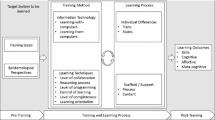Abstract
E-business systems, the most recent generation of information systems, can be effectively used in teaching. One such system was developed and used in a collaborative project that involved teaching of negotiation theory and practice to students from Austria and Canada. The system provides customized course materials and a platform to conduct various e-negotiation activities. The design allows combining e-learning technologies designed to support students in their independent and individual learning with conventional face-to-face training. Our experience indicates that professional negotiation training accompanied by e-learning, and tools to support decision-making and negotiation can foster students' appreciation of the technology as well as demonstrate its limitations. The combination of technology-intensive and conventional resources contributed to students' awareness of social influences on negotiations, importance of communication, and focussed their attention on the problem and its solution. Deeper customization of the course content and delivery may further contribute to effective learning and acquiring of both communication and analytical skills.
Similar content being viewed by others
References
Buffam, W. J. (2000). E-Business and IS Solutions. An Architectural Approach to Business Problems and Opportunities. Boston: Addison-Wesley.
Byrnes, J. F. (2000). “Negotiating with Your Professor: An In-Class Simulation,” in M. Wheeler (ed.), Teaching Negotiation: Ideas and Innovations. Cambridge: PON Books, 369–378.
Chai, L. (2003). “To Have or to Have Not: An Examination of Feedback, Learner Control and Knowledge Type in Online Learning,” in R. H. Sprague (ed.), HICSS. Hawaii: IEEE Computer Society: CD-Rom, 10 pp.
Fournier, R. (1998). A Methodology for Client/Server and Web Application Development. Upper Saddle River: Prentice Hall.
Kersten, G., S. Köszegi, and R. Vetschera. (2002). “The Effects of Culture in Computer-mediated Negotiations,” University of Vienna.
Kersten, G. E. and S. J. Noronha. (1999). “WWW-based Negotiation Support: Design, Implementation, and Use,” Decision Support Systems 25, 135–154.
Lucca, J., N. C. Romano, and R. Sharda. (2003). “An Overview of Systems Enabling Computer Supported Collaborative Learning requiring Immersive Presence (CLCLIP),” in R. H. Sprague (ed.), HICSS. Hawaii: IEEE Computer Society: CD-Rom, 9 pp.
Saunders, D. M. and R. J. Lewicki. (2000). “Teaching Negotiation with Computer Simulations: Pedagogical and Practical Considerations,” in M. Wheeler (ed.), Teaching Negotiation: Ideas and Innovations. Cambridge: PON Books, 357–368.
Shell, G. R. (1995). “Computer-Assisted Negotiation and Mediation: Where We Are and Where We Are Going,” Negotiation Journal 11 (2), 117–121.
Susskind, L. E. and J. Corburn. (2000). “Using Simulations to Teach Negotiation: Pedagogical Theory and Practice,” in M. Wheeler (ed.), Teaching Negotiation: Ideas and Innovations. Cambridge: PON Books, 285–310.
Author information
Authors and Affiliations
Rights and permissions
About this article
Cite this article
Köszegi, S., Kersten, G. On-line/Off-line: Joint Negotiation Teaching in Montreal and Vienna. Group Decision and Negotiation 12, 337–345 (2003). https://doi.org/10.1023/A:1024879603397
Issue Date:
DOI: https://doi.org/10.1023/A:1024879603397




